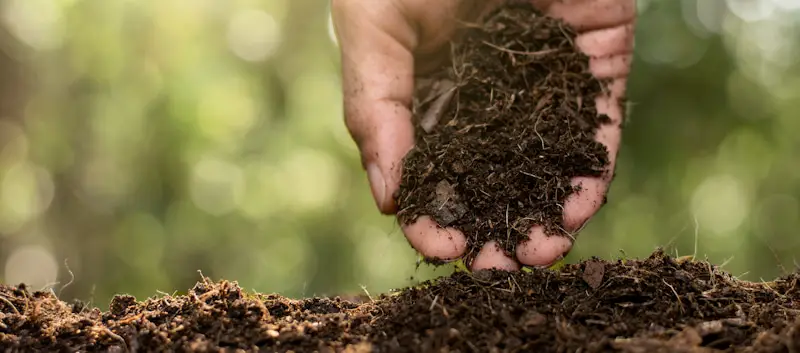One of the important factors to consider when planting is the type of soil available and the best soil suitable for the plant. One of the most recommended houseplants for gardeners is the snake plant because it is a tough plant that occasionally survives when neglected. Nevertheless, you need to ensure you use the best soil for the plant for it to develop healthily.
The best soil for snake plants is a light soil blend with effective drainage that keeps the roots oxygenated and free of clinging wet soil. The soil must be a mix with a slightly alkaline/acidic Ph, within 5.5 – 7.5. This soil type provides the plant with adequate oxygen, nutrients, and moisture.
You must use the right soil for plants because they need a firm base to support the root while nourishing it. Both are important; some soil acts as the firm base but will not properly nourish the root.

What Is The Best Soil For A Snake Plant?
The importance of using good soil for any plant cannot be over-emphasized; for a plant to grow healthily, be nourished, and live long, you need to plant it in good soil. Snake plants come from South Asia and Africa, so these plants can handle dry air with less watering.
However, snake plants do not survive when overwatered, the roots rot, so you need to ensure you use the best soil mix to have a healthy and thriving plant. The soil you use must be damp after watering so the root can absorb the water. The soil must not hold water for a long time.
The best soil for snake plants is a mix of vermiculite, perlite, compost, and organic materials, including peat moss, coarse sand, and sphagnum. The porosity of all these materials helps drain the water from the plant’s roots; it is also best to have a thin layer of pebbles, gravel, or marbles at the bottom of the pot to give the root space to breathe.
You can also use cactus and succulent soils with adequate drainage to keep the roots oxygenated. You should avoid using heavy organic potting soil; this soil can rot and smother the root due to the lack of a good drainage system, so excess water is stored. Every soil you use must be well-drained, well-aerated, and have coarse sand and organic components.
How To Know A Good Snake Plant Soil
Knowing the best soil for snake plants is one thing, but it is another to know the right plant. We will look at what you should look out for when choosing soil for snake plants;
Rich In Nutrient
Unlike humans and animals that get their essential nutrients from what they eat, plants get their nutrients from the soil. So, if a plant is not in good soil, it will be malnourished and not grow healthily. If a soil needs lots of fertilizers, it is not good soil; good soils contain organic materials that keep it fertilized.
Adequate Drainage System
Snake plants are closely similar to cactus; they are succulents; they can store water in their leaves. This characteristic largely determines the type of soil you can use. Since snake plants can store water in their leaves, they do not need soil that will hold water for a long time. The snake plant is susceptible to root rot if the soil does not drain water properly.
Aeration
The soil must be loosely packed so air, water, and nutrients can flow through easily for the snake plant to absorb. Snake plants are native to Africa, where they grow in rocky soil and dry out between watering. The soil you should use must contain materials like gravel, perlite/sand, and clay for efficient air circulation.
Snake Plant Soil Type
Snake plants are tough and drought-tolerant plants that can thrive in dry soil with either slightly acidic or alkaline soil conditions. However, snake plants do not thrive in compact and overly moist soil. Although they thrive in sandy soil, they do better with organic matter to aid robust and healthy growth.
The best soil type to use should be cactus and succulent soil that contains inorganic materials like grit, gravel, sand, and perlite; these make it perfect for growing healthy snake plants. Also, cactus and succulent soil have excellent drainage and aeration that promote root growth and prevent root rot.
Snake Plant Soil Mix
There are different snake plant soil mixes available; there are soil mixes that you can purchase from stores and mixes you can make yourself. We will look at the best ones you can use for your snake plant.
Snake Plant Soil Mix You Can Purchase
Snake plants thrive in potting soil that retains moisture while draining properly. They prefer a mild alkaline or acidic soil mix with a pH of 5.5-7.5. Below are the snake plant soil mixes you can purchase.
Miracle-Gro Potting Indoor Mix
Miracle-Gro Potting Indoor Mix combines lightweight components like coconut coir, perlite, and sphagnum peat moss from a company known for its gardening goods. It drains nicely while retaining the moisture that snake plants require to flourish.
Miracle-Gro provides a mild.25-.13-.19 NPK fertilizer ratio to allow young snake plants to begin at a healthy start. The extra fertilizer is intended to release slowly, so the snake plant will not need to be fertilized for about 6 months.
FoxFarm Forest Organic Ocean Soil Mix
You can grow a bright snake plant with FoxFarm Forest Organic Ocean Soil Mix, which is lightened with natural sphagnum peat moss. Earthworm castings, fish, crab meal, and bat guano are other organic elements. Sandy loam and Forest humus are also included in the mix.
The blend contains no synthetic substances and is made entirely of organic products. The pH of Ocean Forest is between 6.3 and 6.5, which is an excellent range for snake plant growth. It is ready for use immediately out of the bag because it is pre-moistened.
Espoma 8-Quart AP8 Potting Organic Mix
The combination of perlite, alfalfa meal, and sphagnum peat moss in Espoma Organic Potting Mix gives it a soft consistency. Since it drains rapidly, it is ideal for cultivating snake plants. Espoma has a pH of around 6.5 and contains extra organic substances, including earthworm castings and yucca extract, which help plants grow healthy and strong.

DIY Snake Plant Soil Mix
The soil mix for snake plants must be porous and drain properly. These plants will thrive in any cactus or succulent soil. Using basic garden soil or even sterilized garden soil, you can easily make your soil mix. To make your snake plant soil mix, you will need 3 parts potting mix or garden soil, 2 parts organic materials, and 1 part inorganic matter.
First, you will have to mix these materials. The soil will possess a structure but primarily disintegrate if you have a healthy combination of inorganic and organic soil additions. This nutrient-rich, well-draining soil mix feeds the plant and encourages strong root structure.
To test for the texture of your soil mix, wet the soil and pick up a little handful. Gently squeeze the soil in your hand and open your palm. If the soil is a wet clump when you open up your palm, add a little more inorganic matter, but if it crumbles, it has the perfect texture.
Final Thoughts
Plants thrive when grown in the right environment, whereas snake plants imply light soil, drain effectively, and have natural elements. Filling a pot with earth from a yard or an outside raised bed is a bad idea. When snake plants are grown in good soil, they produce the longest leaf spikes of the most vibrant colors. Hence, you must use the appropriate soil mix for these plants.
Keep reading:
- Do Snake Plants Need Light? Here’s Their Light Requirements
- Can Spider Plants Live Outside? Will They Survive?
Victoria is the owner and main author of hobby plants. She loves spending her free time in her garden planting and taking care of her plants. Victoria hopes you enjoy the content here!
![Best Soil For A Money Tree? [DIFFERENCES EXPLAINED] Best Soil For A Money Tree? [DIFFERENCES EXPLAINED]](https://www.hobbyplants.com/wp-content/uploads/2022/08/best-soil-for-money-tree-300x158.jpg)
![The Best Stylish Grow Lights for Indoor Plants [REVIEWED] The Best Stylish Grow Lights for Indoor Plants [REVIEWED]](https://www.hobbyplants.com/wp-content/uploads/2022/07/stylish-grow-lights-for-indoor-plants-300x158.jpg)
![How To Get Rid Of White Bugs In Soil? [PLAN OF ACTION] How To Get Rid Of White Bugs In Soil? [PLAN OF ACTION]](https://www.hobbyplants.com/wp-content/uploads/2022/08/white-bugs-in-soil-300x158.jpg)

![Can Snake Plants Live Outside? [COMPLETE CARE GUIDE] Can Snake Plants Live Outside? [COMPLETE CARE GUIDE]](https://www.hobbyplants.com/wp-content/uploads/2022/08/can-snake-plants-live-outside-300x158.jpg)

![How Often Do You Water A Snake Plant? [FIND OUT HERE] How Often Do You Water A Snake Plant? [FIND OUT HERE]](https://www.hobbyplants.com/wp-content/uploads/2022/07/how-often-do-you-water-a-snake-plant-1-300x158.jpg)
![How To Propagate Snake Plant? [BEGINNER'S GUIDE] How To Propagate Snake Plant? [BEGINNER'S GUIDE]](https://www.hobbyplants.com/wp-content/uploads/2022/08/how-to-propagate-snake-plant-300x158.jpg)
![How to Repot A Snake Plant? [STEP BY STEP GUIDE] How to Repot A Snake Plant? [STEP BY STEP GUIDE]](https://www.hobbyplants.com/wp-content/uploads/2022/08/how-to-repot-snake-plant-300x158.jpg)
![How to Propagate Fiddle Leaf Fig [BEST METHODS] How to Propagate Fiddle Leaf Fig [BEST METHODS]](https://www.hobbyplants.com/wp-content/uploads/2022/06/how-to-propagate-fiddle-leaf-fig-300x158.jpg)

